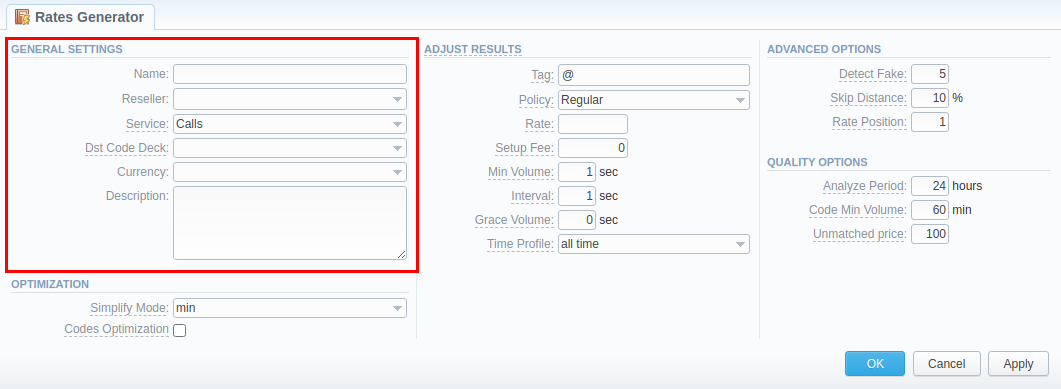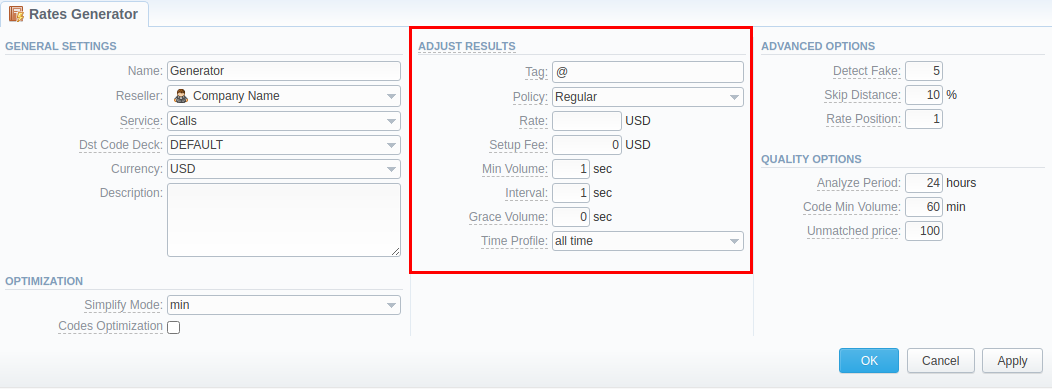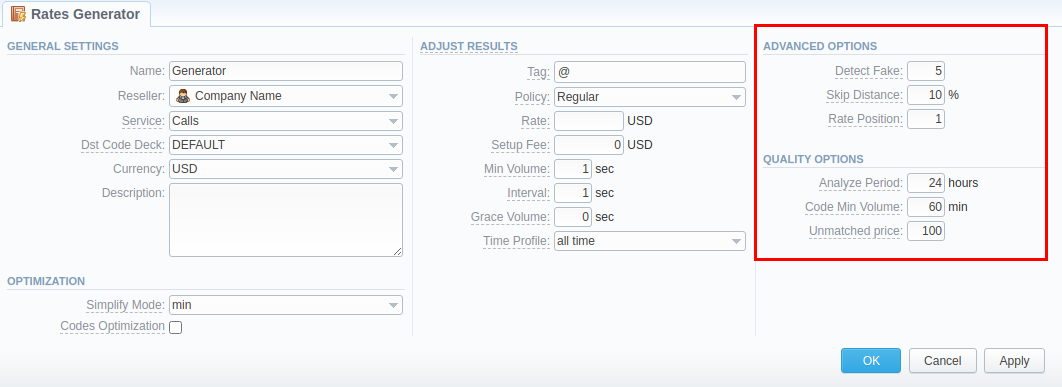Docs for all releases
Page History
...
To create a new rates generator, you need to click the New Rates Generator button and a pop-up creation form will appear. It consists of general and additional settings. The list of general settings includes the following fields:
Screenshot: General settings
| Field | Description |
|---|---|
| Name | Specify the name of a new rates generator |
| Reseller | Select the reseller, to whom a newly created rates generator should belong |
| Service | Choose the service to be applied for the respective rates generator (calls, SMSs, data, etc.). |
| Dst Code Deck | Select the code deck that will be used to name destination codes in a new price list if the Adjust Results option is checked |
| Currency | Specify the currency of rates in a new price list |
| Description | Additional information about a current rates generator |
...
Screenshot: Rates Generator form/Optimization checkbox
| Information Block | Description | |||||||||||||||||||||
|---|---|---|---|---|---|---|---|---|---|---|---|---|---|---|---|---|---|---|---|---|---|---|
| Simplify Mode | It allows applying the same price for all codes inside the same code name by using three options: | |||||||||||||||||||||
| minimum available price. | |||||||||||||||||||||
| maximum available price. | |||||||||||||||||||||
| average price of all available. | |||||||||||||||||||||
| Example | For instance, if the USA code name consists of 3 codes with 1, 5, and 6 USD rates, respectively, depending on a chosen option, the results will be:
| |||||||||||||||||||||
| Codes Optimization checkbox | This option allows compressing an imported code range. For example, 4400-4409 will be shortened to 440. At the same time, 4400-4491 will be shortened to 440, ..., 448, 4490, 4491. | |||||||||||||||||||||
...
Screenshot: Adjust Results information block
| Field | Description | ||||||||||||||||||||||
|---|---|---|---|---|---|---|---|---|---|---|---|---|---|---|---|---|---|---|---|---|---|---|---|
| Tag | Specify a tag that will be applied to new rates, if such were created by a rates generator. Let's leave the default @ tag | ||||||||||||||||||||||
| Policy | Select the policy (regular or additive) that will be applied to code(s), presented in a code deck, but not in a source rate table. For example, Regular policy | ||||||||||||||||||||||
| Rate | Define a rate for codes, which are present in a code deck but missing in a rule's source rate table. For example, 7.5 USD | ||||||||||||||||||||||
| Setup Fee | Define a setup fee for a new rate(s). For example, 8 USD | ||||||||||||||||||||||
| Min Volume | Indicate minimum volume for a new rate(s). 6 sec, for instance | ||||||||||||||||||||||
| Interval | Specify the interval for a new rate(s). For example, 2 sec | ||||||||||||||||||||||
| Grace Volume | Determine grace volume for those rates. For example, 2 sec | ||||||||||||||||||||||
| Time Profile | Define a time profile for a new rate(s). For instance, leave the default all time profile | ||||||||||||||||||||||
| Example | Let's say our DEFAULT code deck contains 5 codes: 1201, 1202, 1203, 1204, 1205. But our source rate table has 4: 1201, 1202, 1203, and 1205. If you enable Adjust Results and specify the above-mentioned fields with respective parameters, a new rate table, created by a rates generator, will consist of 5 codes: 1201,1202, 1203, 1205 with their original parameters and a new 1204 code with the following ones (see screenshot above):
If a source rate table misses more than 1 code from the selected code deck, all added codes will have identical parameters, specified in the respective fields above. |
...
Screenshot: Advanced and Quality Options information block
The Advanced Options information block is designed to resolve cases when rates generator rules are created for different source rate tables that share certain identical codes. By specifying the following fields, you can configure what will the rate system use for these codes:
...







